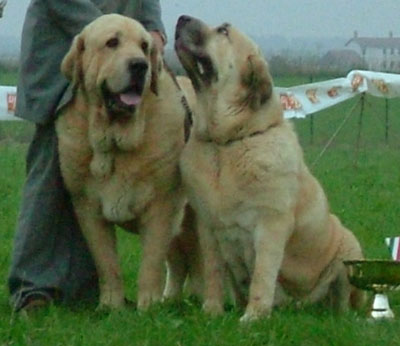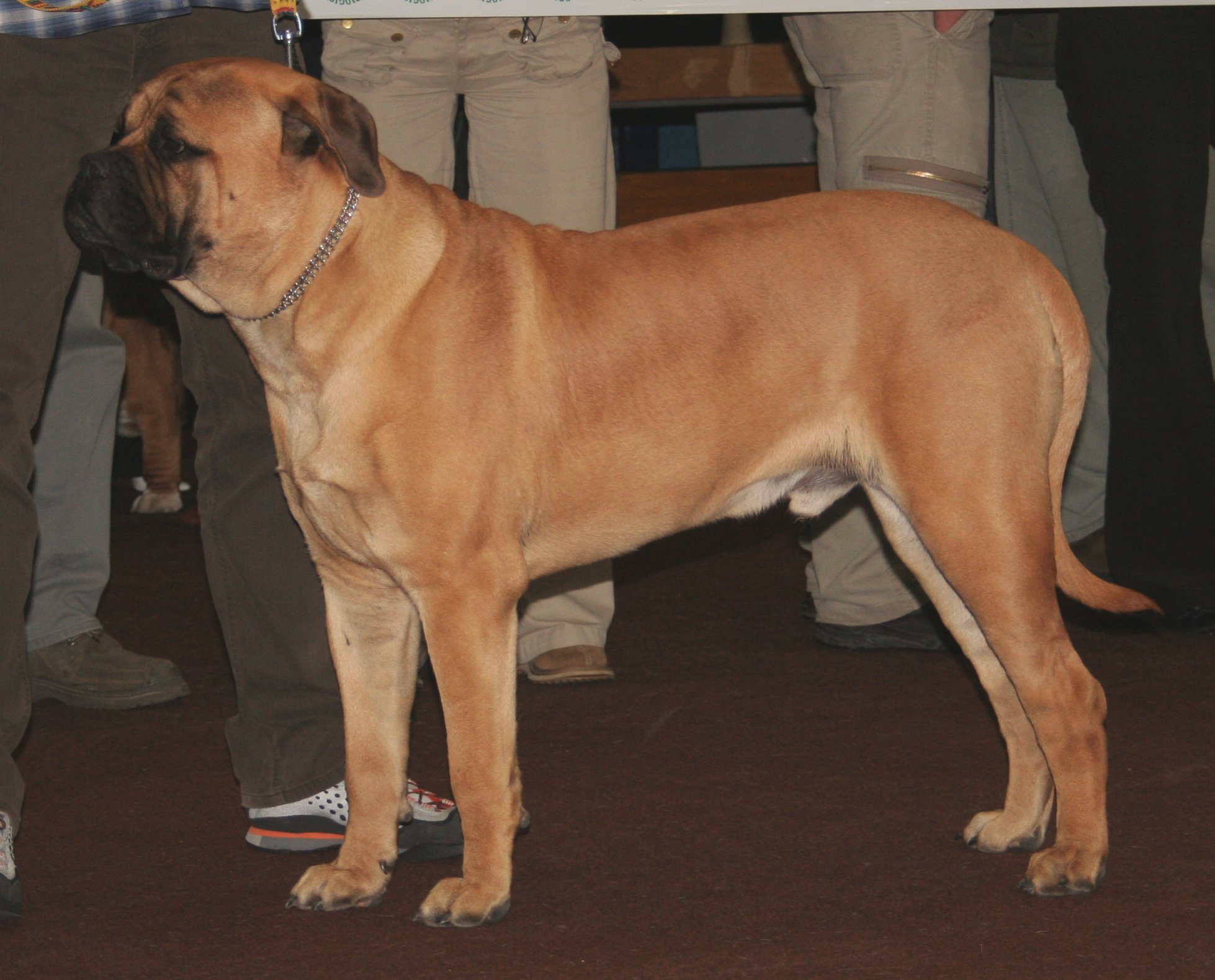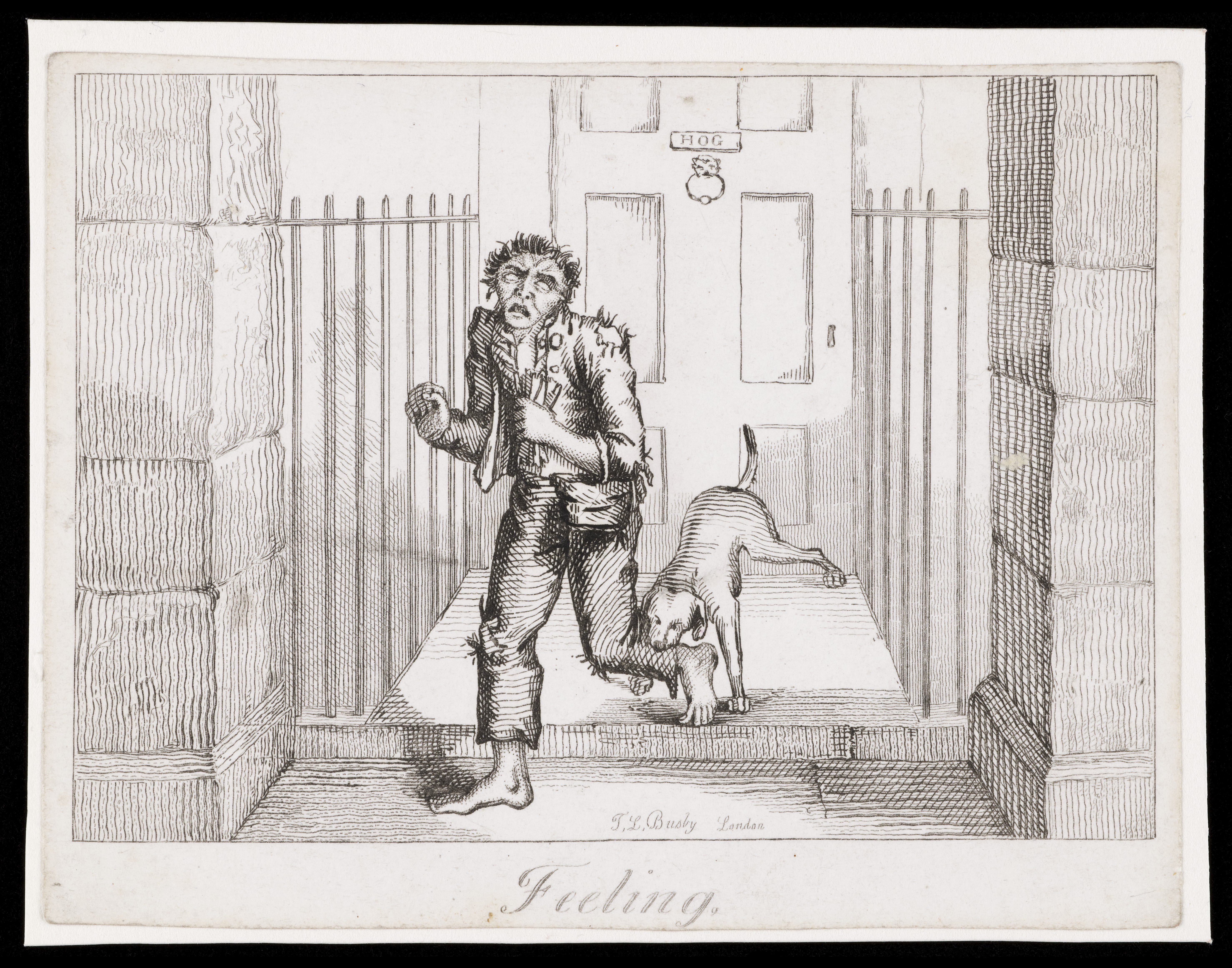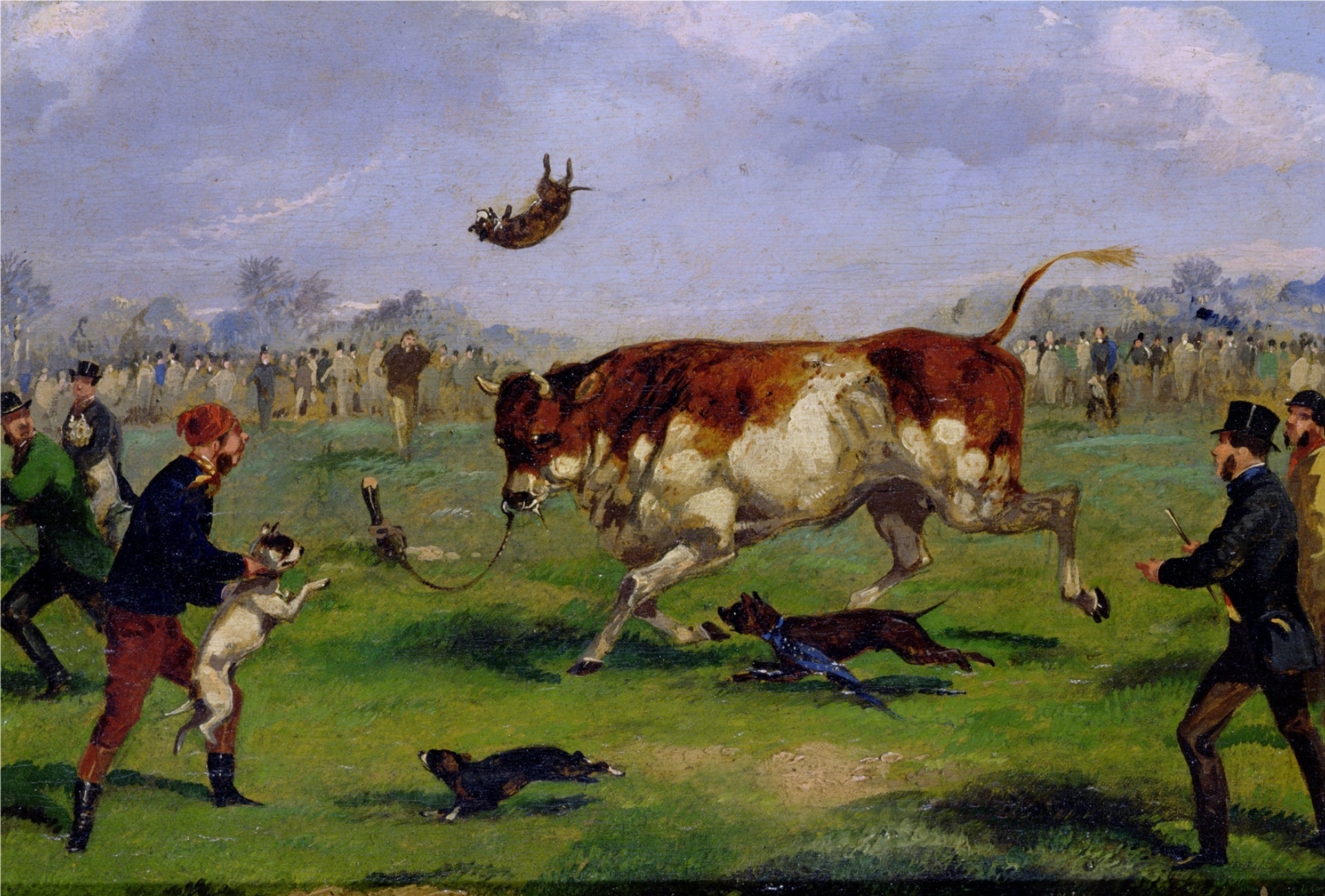|
Mastiff
A mastiff is a large and powerful type of dog. Mastiffs are among the largest dogs, and typically have a short coat, a long low-set tail and large feet; the skull is large and bulky, the muzzle broad and short (brachycephalic) and the ears drooping and pendant-shaped. European and Asian records dating back 3,000 years show dogs of the mastiff type. Mastiffs have historically been guard dogs, protecting homes and property, although throughout history they have been used as hunting dogs, war dogs and for blood sports, such as fighting each other and other animals, including bulls, bears and even lions. Historical and archaeological evidence suggests that mastiffs have long been distinct in both form and function from the similarly large livestock guardian dogs from which they were most likely developed; they also form separate genetic populations. The Fédération Cynologique Internationale and some kennel clubs group the two types together as molossoid dogs; some modern livest ... [...More Info...] [...Related Items...] OR: [Wikipedia] [Google] [Baidu] |
Tibetan Mastiff
The Tibetan Mastiff ( bo, འདོགས་ཁྱི, THL: , Wylie: ) * Nepali: * Mongolian: * Hindi/Garhwali/ Kumaoni: * Kashmiri: * Ladakhi: * Dzongkha: is a large size Tibetan dog breed. Its double coat is medium to long, subject to climate, and found in a wide variety of colors, including solid black, black and tan, various shades of red (from pale gold to deep red) and bluish-gray (dilute black), and sometimes with white markings around neck, chest and legs. Name The term ''mastiff'' was assigned by the Europeans who first came to Tibet because that name was used to refer to nearly all large dog breeds in the West. Early Western visitors to Tibet misnamed several of its breeds, such as the Tibetan terrier, which is not a terrier, and the Tibetan spaniel, which is not a spaniel. A better name for the breed might be the ''Tibetan mountain dog'' or—to encompass the landrace breed throughout its range—the ''Himalayan mountain dog''. Description Appearance ... [...More Info...] [...Related Items...] OR: [Wikipedia] [Google] [Baidu] |
Spanish Mastiff
The Spanish Mastiff or Mastín Español is a breed of dog from Spain, originally bred to be a guard dog and whose specialized purpose is to be a livestock guardian dog protecting flocks and/or herds from wolves and other predators. Historical context In medieval times, this dog has accompanied the herds of sheep crossing from northern to southern Spain, defending cattle from attack by wolves and other predators. The mastiff had the protection of chunky metal necklaces with skewers. Its function was primarily protective, unlike its fellow Carea dogs, whose function is grazing, driving the herds in response to indications of the shepherd. In some places it is known as ''perro merinero'' when it accompanies sheep of the Merino breed. The first breed standard of the Spanish Mastiff was made by the FCI in 1946. In 1981 the Asociación Española del Perro Mastín Español was formed, who organized a breeding program looking for the kind of large and strong mastiff of the past time ... [...More Info...] [...Related Items...] OR: [Wikipedia] [Google] [Baidu] |
Livestock Guardian Dog
A livestock guardian dog (LGD) is a dog type bred for the purpose of protecting livestock from predators. Livestock guardian dogs stay with the group of animals they protect as a full-time member of the flock or herd. Their ability to guard their herd is mainly instinctive, as the dog is bonded to the herd from an early age. Unlike herding dogs which control the movement of livestock, LGDs blend in with them, watching for intruders within the flock. The mere presence of a guardian dog is usually enough to ward off some predators, and LGDs confront predators by vocal intimidation, barking, and displaying very aggressive behavior. The dog may attack or fight with a predator if it cannot drive it away. History Herding dogs originated in Western Asia, on the territory of modern Iran and Iraq in association with the beginning of livestock breeding. Domestication of sheep and goats began there in the 8-7th millennium BC. Back then shepherding was a difficult job: first shepherds di ... [...More Info...] [...Related Items...] OR: [Wikipedia] [Google] [Baidu] |
Dog Fighting
Dog fighting is a type of blood sport that turns game and fighting dogs against each other in a physical fight, generally to the death, for the purposes of gambling or entertainment to the spectators. In rural areas, fights are often staged in barns or outdoor pits; in urban areas, fights are often staged in garages, basements, warehouses, alleyways, abandoned buildings, neighborhood playgrounds, or in the streets. Dog fights usually last until one dog is declared a winner, which occurs when one dog fails to scratch, dies, or jumps out of the pit. Sometimes dog fights end without declaring a winner; for instance, the dog's owner may call the fight. Dog fighting generates revenue from stud fees, admission fees and gambling. Most countries have banned dog fighting, but it is still legal in some countries, such as Honduras, Japan, and Albania. (in Albanian) The sport is also popular in Russia. History Europe Blood sports in general can be traced back to the Roman Empi ... [...More Info...] [...Related Items...] OR: [Wikipedia] [Google] [Baidu] |
Bullmastiff
The Bullmastiff is a British breed of dog of mastiff type and large size, with a solid build and a short muzzle. It was developed as a guard dog in the nineteenth century by cross-breeding the English Mastiff with the now-extinct Old English Bulldog. It was recognised as a breed by The Kennel Club in 1924. History The origins of the Bullmastiff are unclear. In the eighteenth century, in some regions of England, the Old English Mastiff and English Bulldog were commonly inter-bred to produce dogs suitable for work guarding people and their property. By the beginning of the twentieth century this cross-breed was in widespread use as an aid to gamekeepers in the control of poaching. They were bred by gamekeepers for strength, size and speed using a cross of the tough, heavy and aggressive Bulldog of the nineteenth century with the large, strong, less aggressive Mastiff.Walkey B. The Bullmastiff Fancier's Manual. Sechelt B.C., Canada: Coast Arts Publishing; 1992 As a result, the ... [...More Info...] [...Related Items...] OR: [Wikipedia] [Google] [Baidu] |
Pyrenean Mastiff
The Pyrenean Mastiff or Mastín del Pirineo is a Spanish breed of large livestock guardian dog from the autonomous community of Aragón in north-eastern Spain. It was traditionally used to protect flocks during the annual transhumance to high summer pasture in the Pyrenees. It is a distinct and separate breed from the Spanish Mastiff or Mastin Español and from both the Pyrenean Mountain Dog and the Pyrenean Shepherd. History The Pyrenean Mastiff originated in the historic Kingdom of Aragon, where it has been documented since the Middle Ages. Its origins and purpose were in the annual transhumance of flocks to the high pastures of the Pyrenees for the summer months, and the return to lower ground for the winter. The dogs were kept with the sheep from an early age; their job was to protect the flocks from predators, and in particular from wolves. Like other European flock guardian breeds, they were often fitted with a spiked metal wolf collar or for extra protection. Three of ... [...More Info...] [...Related Items...] OR: [Wikipedia] [Google] [Baidu] |
Coat (dog)
The coat of the domestic dog refers to the hair that covers its body. Dogs demonstrate a wide range of coat colors, patterns, textures, and lengths. As with other mammals, a dog's fur has many uses, including thermoregulation and protection from cuts or scratches; furthermore, a dog's coat plays an important role in the showing of purebred dogs. Breed standards often include a detailed description of the nature and attributes of that breed's ideal coat. A dog's coat is composed of two layers: a top coat of stiff guard hairs that help repel water and shield from dirt, and an undercoat of soft down hairs, to serve as insulation. Dogs with both under coat and top coat are said to have a ''double coat''. Dogs with a ''single coat'' have a coat composed solely of guard hairs, with little or no downy undercoat. The terms fur and hair are often used interchangeably when describing a dog's coat, however in general, a double coat, like that of the Newfoundland and most livestock g ... [...More Info...] [...Related Items...] OR: [Wikipedia] [Google] [Baidu] |
Guard Dog
A guard dog or watchdog (not to be confused with an attack dog) is a dog used to watch for and guard property against unwanted or unexpected human or animal intruders. The dog is discerning so that it does not annoy or attack the resident humans of the house. History The use of dogs as guardians is well known since ancient times. The Romans used to put mosaics (''Cave canem'' mosaics) at the entrance of the houses to warn visitors and intruders of the presence of dangerous dogs at the property. One of the first dog types used as guardians were the ancestral Mastiff-type landraces of the group known as Livestock guardian dogs which protected livestock against large predators such as wolves, bears and leopards. Orthrus is a famous example of a livestock guardian dog from the Greek mythology known for guarding Geryon's red cattle. Some ancient guard dogs in more urban areas, such as the extinct bandogges, were chained during the day and released at night to protect propertie ... [...More Info...] [...Related Items...] OR: [Wikipedia] [Google] [Baidu] |
War Dog
Dogs in warfare have a very long history starting in ancient times. From being trained in combat, to their use as scouts, sentries, messengers, mercy dogs, and trackers, their uses have been varied and some continue to exist in modern military usage. History War dogs were used by the Egyptians, Greeks, Persians, Sarmatians, Baganda, Alans, Slavs, Britons, and Romans. Among the Greeks and Romans, dogs served most often as sentries or patrols, though they were sometimes taken into battle. The earliest use of war dogs in a battle recorded in classical sources was by Alyattes of Lydia against the Cimmerians around 600 BC. The Lydian dogs killed some invaders and routed others. At the Battle of Pelusium (525 BC), Cambyses II deployed dogs, cats, and other animals held sacred by the Egyptians. By putting these animals in the front lines, he was supposedly able to get the Egyptians to cease using their projectile weaponry. During the Late Antiquity, Attila the Hun used la ... [...More Info...] [...Related Items...] OR: [Wikipedia] [Google] [Baidu] |
Alano Español
The Alano Español or Spanish Bulldog is a Spanish breed of medium to large sized dog of alaunt-bulldog type. It has at various times been used as a war dog, for bullfighting, for the management of cattle, for hunting and as a guard dog. In the later twentieth century it became an endangered breed; a recovery project was launched, and numbers have since recovered. It was officially recognised under national law in 2004. History The origins of the Alano Español are unknown. One hypothesis is that it derives from dogs brought to Spain in the Migration Period in the fifth century by the Alani, a nomadic pastoralist people from Central Europe. The first written reference to the breed in Spain is in a chapter of the fourteenth-century ("Book of the Hunt of Alfonso XI"), in which hunting dogs called ''Alani'' are described as having beautiful colours. [...More Info...] [...Related Items...] OR: [Wikipedia] [Google] [Baidu] |
Spain
, image_flag = Bandera de España.svg , image_coat = Escudo de España (mazonado).svg , national_motto = ''Plus ultra'' (Latin)(English: "Further Beyond") , national_anthem = (English: "Royal March") , image_map = , map_caption = , image_map2 = , capital = Madrid , coordinates = , largest_city = Madrid , languages_type = Official language , languages = Spanish language, Spanish , ethnic_groups = , ethnic_groups_year = , ethnic_groups_ref = , religion = , religion_ref = , religion_year = 2020 , demonym = , government_type = Unitary state, Unitary Parliamentary system, parliamentary constitutional monarchy , leader_title1 = Monarchy of Spain, Monarch , leader_name1 = Felipe VI , leader_title2 = Prime Minister of Spain ... [...More Info...] [...Related Items...] OR: [Wikipedia] [Google] [Baidu] |
Bull-baiting
Bull-baiting is a blood sport involving pitting a bull against dogs. History England Crowds in London during the Royal Entry of James VI and I in March 1604 were entertained by bull-baiting. During the time of Queen Anne, bull-baiting was practised in London at Hockley-in-the-Hole, twice a week – and was also reasonably common in provincial towns, for instance at Birmingham's Bull Ring. At Tutbury, a bull was tied to an iron stake so that it could move within a radius of about 30 feet. The object of the sport was for the dogs to immobilize the bull. Before the event started, the bull's nose was blown full of pepper to enrage it before the baiting. The bull was often placed in a hole in the ground. A variant of bull-baiting was "pinning the bull", where specially-trained dogs would set upon the bull one at a time, a successful attack resulting in the dog fastening his teeth strongly in the bull's snout. The extinct Old English Bulldog was specially bred for this sport ... [...More Info...] [...Related Items...] OR: [Wikipedia] [Google] [Baidu] |










.jpg)
